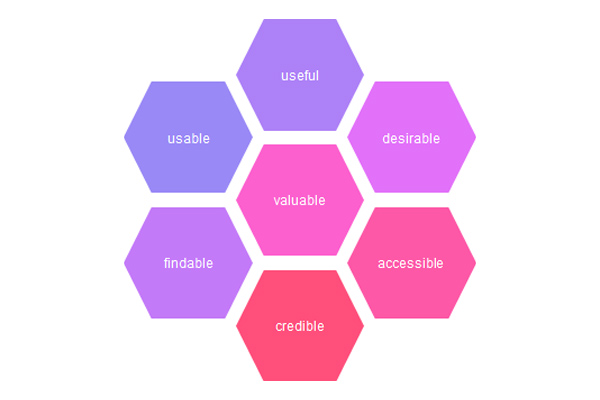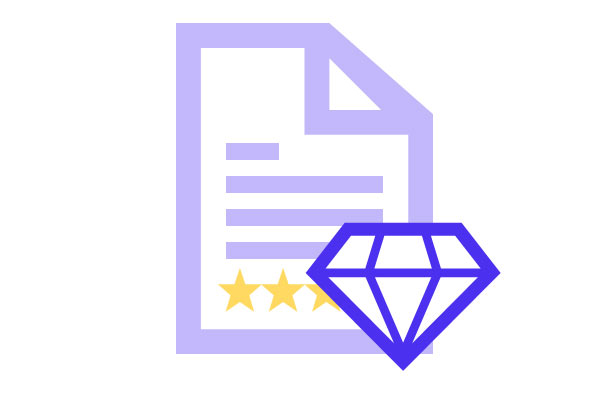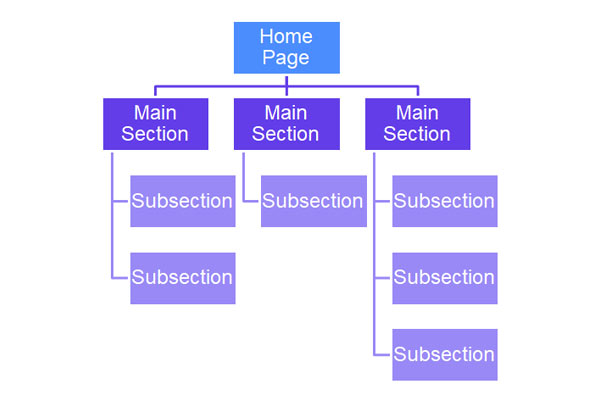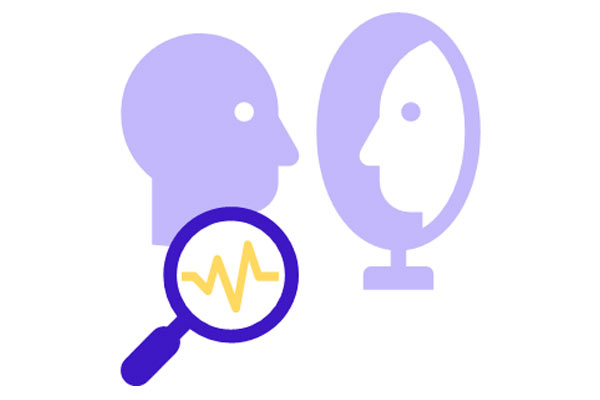UX = User Experience
SEO = Search Engine Optimisation
What us UX?
User Experience (UX) is really in the name, it’s about the experience a user has when they interact with a product, system or service. UX involves both digital and physical experiences.
UX design focuses on the process of improving UX. UX design is about understanding the factors that make up a User’s Experience and using that knowledge to guide the design and development of products, systems or servicers. You’re designing from a user’s perspective.
While UX pertains to a wide array of experiences, in this presentation, I’m specifically addressing website UX.
UX design is such a massive field and there are a range of methods you can use to improve your websites UX. I found Peter Morville UX Honeycomb something I easily understood. It breaks down the factors that make up UX.
Here is Peter Morvilles UX honeycomb
Morville, P. (2004, June 21). User Experience Design. Retrieved from Semantic Studios: http://semanticstudios.com/user_experience_design/

And here are the points explained by usability.gov https://www.usability.gov/what-and-why/user-experience.html
- Useful: Your content should be original and fulfill a need
- Usable: Site must be easy to use
- Desirable: Image, identity, brand, and other design elements are used to evoke emotion and appreciation
- Findable: Content needs to be navigable and locatable onsite and offsite
- Accessible: Content needs to be accessible to people with disabilities
- Credible: Users must trust and believe what you tell them
www.usability.gov. (2023). User Experience Basics. Retrieved from www.usability.gov: https://www.usability.gov/what-and-why/user-experience.html
So how does UX helps SEO?
When you look at the core purpose for SEO, you can easily see why UX affects SEO. The primary goal of SEO is to enhance the searchability and findability of your website by search engines. What do search engines aim to achieve? Search engines aim to attract as many users as possible. UX is very import to search engines, as it’s a key factor in making their service more favourable to users. Consequently, to enhance your website’s SEO, it’s essential to optimize your website’s UX.
It is definitely noticeable that popular search engines like google are popular because they provide good UX. When using google it’s easy to find what you are searching for within the first few results. I definitely notice a difference when using other search engines, it often takes longer to find what I am looking for. Popular search engines provide Search Engine Results Pages (SERPs) that have been optimised to provide exceptional user experience.
Website UX factors that affect SEO:
- Page Load Speed
- Content Quality
- Website Structure and Navigation
- Mobile Responsiveness
- Accessibility
UX metrics
- Back link profile
- Bounce Rate
- Click Through Rate (CTR)
Page Load Speed
It’s quite obvious how the load speed affects user’s experience. It’s also one of the first things a user will experiences on your website. The faster something load the better user experience. These days users expect websites to load pretty instantly, if they don’t they are more likely to leave the website. Knowing this search engines will rank a website poorly if they have high page load times. The ideal load speed for a website is based on how long a user will wait for a page to load before leaving the page.
- 1 in 4 visitors leave a site that takes more than 3 seconds to load
- Every second delay reduces user satisfaction by 16%
- It is recommended to aim for a 1 – 3 second page load speed.

Content Quality
Create content that is USEFUL to your users. Often in UX design it is said you must create content that serves your users first not search engines. You need to write your content is a way that fulfils your users’ needs in the most effective and efficient way possible. Creating USEFUL content will improve the quality of your content, improving your SEO.
Make your content more useful by:
- Placing important content first
- Use key words thoughtfully (don’t jeopardise a uses experience by over using keywords to the point where what you have written no longer makes sense or is no longer useful to the user)
- Summarize key point to make your content more memorable and easier to digest
- Break up text heavy content with use of original images and infographics

Website Structure and Navigation
The structure of your website will affect how your users find and navigate content on your website. Search engines use the structure of your website to search and index your website. A website that has a structure which is focus on users will improve search engines understanding of what your website is actual about.
The most popular website structure is Hierarchical or tree-like structure.

Mobile Responsiveness
It would be considered poor UX design if users could not easily use your website on a mobile phone. Most people use a mobile phone for using the web over other devices like a desktop. It is good practice to design for mobile first then design for desktop.
Over 55% of website traffic comes from mobile devices.
Howarth, J. (2023, November 1). Internet Traffic from Mobile Devices (Nov 2023). Retrieved from explodingtopics.com: https://explodingtopics.com/blog/mobile-internet-traffic

Accessibility
Accessibility is separate to usability in UX design even though it can be said that if something is not accessible it is not usable. Accessibility is separated to put an emphasis on the importance of accessibility. Usability is whether the website can be used by a user for its intended purpose and the user is able to meet there need in using the website. Accessibility is more about if your website can be used by all users, including users with disabilities.
SEO and Accessibility work together. Having accessible websites are more likely to rank higher as they offer better UX to people with disabilities. Help web crawlers will rank content higher if it meets Web Content Accessibility Guidelines WCAG 2.1. Using this guideline will improve your UX and could be something that makes your website more desirable.
User Experience (UX) metrics
How can you assess whether your website offers a positive or negative user experience? How do you measure the effectiveness of the UX improvements you’re implementing and their impact on SEO? Certain user metrics provide valuable insights into your website’s UX performance and can also shed light on your website’s overall SEO status.
UX metrics that impact SEO:
- Backlink Profile
- Bounce Rate
- Click through rate (CTR)

References
Backlinko. (2023). User Experience Signals – Organic CTR. Retrieved from backlinko.com: https://backlinko.com/hub/seo/organic-ctr
Baker, L. (2022, June 10). 12 Essential On-Page SEO Factors You Need To Know. Retrieved from Search Engine Journal – SEO, Search Marketing News and Tutorials: https://www.searchenginejournal.com/on-page-seo/essential-factors/
DashClicks Team. (2021, Dec 06). How to Improve SEO With User Experience Factors. Retrieved from www.dashclicks.com: https://www.dashclicks.com/blog/how-to-improve-seo-with-user-experience-factors
Howarth, J. (2023, November 1). Internet Traffic from Mobile Devices (Nov 2023). Retrieved from explodingtopics.com: https://explodingtopics.com/blog/mobile-internet-traffic
Interaction Design Foundation – IxDF. (2016, June 1). What is Accessibility? Retrieved from Interaction Design Foundation – IxDF: https://www.interaction-design.org/literature/topics/accessibility
Karpiński, M. (2023, Feb 20). How to Improve Website Navigation for SEO. Retrieved from SUSO: https://susodigital.com/blog/how-to-improve-website-navigation-for-seo#:~:text=Website%20navigation%20not%20only%20plays,selected%20key%20phrases%20much%20faster
Khorev, M. (2023). Top 10 SEO Ranking Factors [2021 Update]: What Matters To Google. Retrieved from mikekhorev.com: https://mikekhorev.com/seo-ranking-factors
Morville, P. (2004, June 21). User Experience Design. Retrieved from Semantic Studios: http://semanticstudios.com/user_experience_design/
Nair, S. (2023, January 27). Top 10 Off Page Ranking Factors. Retrieved from /www.seopowersolutions.com: https://www.seopowersolutions.com/top-10-off-page-ranking-factors/
Osypenko, A. (2023, JUn 16). How to plan and create a solid website structure, and why it’s important for SEO. Retrieved from SE Ranking: https://seranking.com/blog/website-structure/
usability.gov. (2019). Information Architecture Basics. Retrieved from usability.gov: https://www.usability.gov/what-and-why/information-architecture.html
userway.org. (n.d.). SEO and Accessibility Go Hand in Hand: Here’s Why. Retrieved from userway.org: https://userway.org/blog/the-impact-of-accessibility-on-seo/#:~:text=Accessibility%20is%20not%20an%20SEO,content%20better%20and%20improve%20searchability
Wesolko, D. (2016, Jun 15). Peter Morville’s User Experience Honeycomb. Retrieved from danewesolko.medium.com: https://danewesolko.medium.com/peter-morvilles-user-experience-honeycomb-904c383b6886
Wordstream. (2019). Search Engine Optimization – Learn to Optimize for SEO. Retrieved from Wordstream.com: https://www.wordstream.com/seo
www.usability.gov. (2023). User Experience Basics. Retrieved from www.usability.gov: https://www.usability.gov/what-and-why/user-experience.html